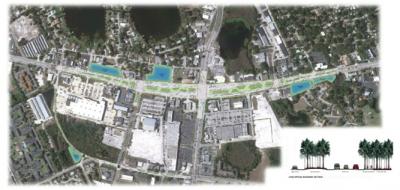
Highway Fight In Orlando Highlights National Dichotomy In Transportation Planning
Putting the brakes on the Orlando - Casselberry Flyover
Submitted on 05/15/2013. Tags for this image:Just outside of Orlando, in the City of Casselberry, residents and business owners are interrupting plans that will allow a deluge of traffic to travel through - or rather, over – their town.
At the intersection of U.S. 17-92 and S.R. 436, the Department of Transportation is slated to begin construction on a flyover bridge which it says will alleviate congestion. Over the past several years, the state has poured tens of millions of dollars into acquiring adjacent land. And finally this September, the construction crews are coming in.
But Richard Birdoff, President of RD Management in New York and owner of the Orlando Jai-Alai Fronton as well as more than 50 acres of developable land nearby says that the proposed flyover will destroy the economic value of the intersection, reducing the values of the existing properties in the immediate area.
“Flyovers are rarely constructed where there is economic wealth and development, and they tend to cause blight and have a chilling effect on economic development and property values,” says Birdoff, in an interview with CNU. “All you have to do is go down the road three miles to the flyover that was built at the intersection of 50 and 436 and you can see the detrimental impact it has had on the local retailers.”
Former Casselberry Commissioner Jon Miller claims the opposite (the flyover will connect Orlando with the City of Casselberry). Last year in the Orlando Sentinel, Miller said that the flyover would be a catalyst for economic growth. He also promised that the structure would be attractive – like "something you would see at Disney."
Research continually shows that Birdoff is correct - building more roads and bridges does not bring more visitors. What they bring is more congestion.
CNU President John Norquist, who recently spoke with a group of more than 200 in Casselberry rallying against the DOT’s proposal, puts it more bluntly: “Does Casselberry want to be a destination or just a great place you drive a truck through?”
Birdoff has done an impressive job of leading the charge against the flyover, hiring firms to conduct studies of alternatives and to look at the actual need. One such alternative, a “Boulevard” concept will not only improve the movement of traffic at the intersection but will also enhance economic development at the intersection, increase tax ratables and property values, and create jobs. The cost of the “Boulevard” alternative is also $10,000,000 less expensive than the flyover.
And in fact, traffic at the location has actually diminished since the plan was launched back in the early 2000s. “The DOT’s 2002 study showed that peak time evening traffic volume through the intersection was 8,930 cars. They projected that in 2010 there would be 11,862 cars. I hired a firm to update the traffic counts in 2012, and they counted 7,964 vehicles travelling through the intersection at evening peak hour. So not only was it less than projected, but it was even less than it was back in 2002.”
The situation in Orlando represents a national dichotomy in transportation planning. Transportation engineers and planners are still taught that speed is good, and that cities should have high-speed freeways bisecting them and cutting through neighborhoods. But some local, regional, and state transportation departments are embracing alternative models to the highway model (e.g., San Francisco and Portland) that leave the vital density of cities intact.
Learning (or Not Learning) from the Past
In the 1950s and 60s, in the name of economic development, the French Quarter in New Orleans was nearly walled off by a multi-lane expressway along the Mississippi River and Jackson Boulevard. It was the efforts of local preservationists that eventually warded off the auspices of “urban renewal” – essentially, the tearing down of historical buildings, districts, and neighborhoods in the name of removing blight.
To Norquist and others in the new urbanist movement, too many have forgotten just how close New Orleans came to having its unique, Cajun- and French-infused architecture ravished. Unfortunately, residents of the nearby Tremé neighborhood were less than successful in their efforts against urban renewal and have been living with the scars of the Claiborne Expressway for decades. Certainly the planners and engineers in Casselberry could learn a thing or two from New Orleans.
Too Late?
Some have argued that it’s simply too late to stop the flyover from going up. The July deadline is nigh. Much money has already been spent. But Birdoff’s focused attack has had an impact: the DOT has come around to the Boulevard alternative. “They basically told me, 'If you can get local support for the Boulevard plan, we’re willing to consider not doing the flyover and move ahead with the at-grade improvement.' The alternative would use all of the right-of-way that the DOT has already claimed, so no money will have been wasted.”
A decision by the Casselberry Commission is imminent – it is on the agenda for their next meeting, happening in June.
“I hope the Casselberry commissioners have the courage to change direction and support the Boulevard plan,” says CNU President John Norquist. “If you really want jobs and economic development, putting in new freeways is the wrong way to go.Just because a decision made over ten years ago seemed appropriate at the time, it doesn’t mean we should be locked into it if better alternatives are now available.”
____________________________________________________________________________________________________
You can download a presentation prepared by Kimley-Horn and Associates explaining the benefits of the boulevard plan here.


